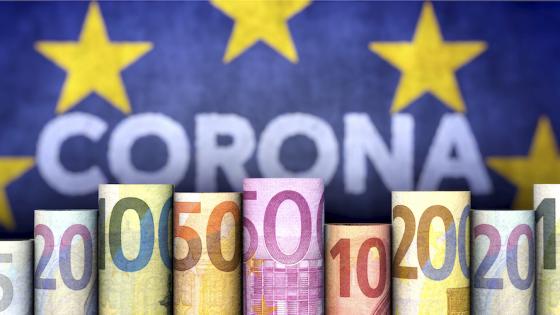There are now several proposals for initiatives to complement the vigorous decision of the ECB to launch a mega ‘pandemic emergency purchase programme’ (PEPP) with fiscal and financial initiatives at European level. These proposals all start from a number of agreed points.
- The COVID crisis is an exceptionally large exogenous shock affecting all EU member states. It is still too early to say whether all will be affected with the same intensity. In any case, the pandemic by definition is borderless: its successful control in any country is a public good for an integrated economy such as the EU where value chains cannot be restarted properly if important suppliers in partner countries remain idle or if major intra-EU borders remain closed.
- Responsibility to safeguard the Single Market lies with national governments, but the backing of the central bank is key because this crisis involves a huge fiscal cost whose magnitude cannot be determined in advance, and because it is not certain that the corresponding debt issuance can be absorbed by financial markets. For euro area member states, this means backing by the ECB. The role of the central bank is to avoid both inflation and deflation, but also prevent self-fulfilling sovereign debt panics and to buy time for the member states that will then be able to spread the cost of the crisis over a long period.
- Although ECB large asset purchases can be justified as necessary to protect the integrity of the euro area, its action as a backstop to single states could be challenged on the basis of its political legitimacy. For this reason, there is a need for fiscal and financial instruments at the euro area level.
- Idiosyncratic or single country risks could in principle be addressed by the European Stability Mechanism (ESM) adjustment programmes and the Outright Market Transactions (OMTs) scheme. However, it would be wise not to come to the point where these emergency rescue instruments need to be activated, as it would be costlier for all involved than earlier action.
Against this common background, the proposals on the table differ along five dimensions:
- Objective: some schemes explicitly aim at sharing the burden of the COVID crisis among member states and therefore involve explicit temporary transfers. Some rather aim at providing a common shield to the member states, while minimizing distributional implications.
- Mutualisation: all proposals involve a modicum of mutualisation. But channels and amounts differ. Some scholars have proposed to let the European Commission, the ESM or a special purpose vehicle lend to all national governments at the same rate, while keeping each member state solely responsible for its debt (borrowing cost mutualisation). In contrast, a proper Eurobond or its temporary variant (the Coronabond) would involve one-off borrowing to finance common actions (expenditure-side mutualisation).
- Institutional features: some proposals rely on existing instruments (ESM credit lines, EU budget); others rely on adjusting existing instruments (an ESM COVID credit line); others envisage dedicated instruments such as a special-purpose vehicle.
- Conditionality: some instruments intend to address the COVID crisis itself, and they are hence free from usual conditionalities; others address the risk of a sovereign debt crisis and envisage some conditionality; others are intended to buttress the economic recovery.
- Scope: it can be the EU or the euro area, as there is both a need to preserve the single market and to avoid a euro-specific sovereign debt crisis.
Three distinct aims can, and should, be pursued:
- To share the cost of the crisis if it turns out to be significantly asymmetric (the extent of which is not yet known). This would imply designing mechanisms that involve temporary transfers (ex post), but only if the shock turns out to be actually asymmetric.
- To help all member states – including those whose initial fiscal position is weak –COVID-19: Europe needs a catastrophe relief plan and finance their crisis-fighting needs. This requires, when the instrument involves debt, that the maturity be very long, for example 30 years. The goal here is to make sure that all member states have the possibility to tackle the public health and economic emergencies while retaining market access. If asymmetry arises from the initial position, not from the shock, the aim should not be to share the burden but to ensure that each member state can pull itself out of the crisis.
- To relaunch the EU after the crisis, since not only member states have come to a halt but also the EU as a whole, with the closure of frontiers, the disruption of most of its programmes (Erasmus, et al.) and the new challenges that the COVID crisis poses, starting with the need to treat health safety as a public good for the EU.
Drawing on the various proposals advanced by European institutions, member states and academics, we believe that multiple initiatives are necessary at the European level. We specifically propose that support should be given to three instruments: a COVID Fund, EIB credit guarantees and dedicated credit lines.
1. A COVID Fund
Proposals for a COVID Fund aim at expenditure-side mutualisation to help the EU assist the worse-hit member states. The logic of these proposals is to provide a conduit for temporary and limited crisis-related transfers. Funds should be allocated depending on the severity of the crisis and the magnitude of the corresponding needs. They could finance common expenditures (on research, procurement, etc..) or provide grants to affected member states, depending on how severely they are hit. They would in turn be financed through time-bound dedicated resource commitments by all member states based on an objective basis for proportionality (such as gross national income). For example, each member state would annually contribute a fraction of its GNI over a period of ten years. The fund would be balanced inter-temporarily but expenditures could be front-loaded and temporarily financed by borrowing on the market through some form of joint issuance, as some of us have proposed. It would be terminated once contributions have extinguished the debt.
A fund of this type would express solidarity in a direct and concrete way. Its size would depend on the scope of its actions, which could range from health-related expenditures to a broader sharing of asymmetric damages. It could also complement the EU budget to address the special needs that the rebooting of the economy will require.
2. EIB credit guarantees
The lives of many smaller companies are being threatened by the collapse of their market. Even if they remain solvent, their liquidity needs have increased dramatically and often fail to be met by banking institutions under stress. This is why credit guarantees are necessary. Several member states have already launched major programmes to ensure that banks will extend credit to struggling companies, but there is a need to buttress these initiatives by a similar move at EU level. The European Investment Bank (EIB) has experience in extending such guarantees through the banking system. Beefing up the EIB may prove instrumental in avoiding a major weakening of our production potential.
3. Dedicated credit lines
A family of proposals aims at providing a channel for long-term financing, such as the COVID credit line from the ESM proposed by some of us (Bénassy-Quéré et al. 2020) and the SURE proposal (temporary Support to mitigate Unemployment Risks in an Emergency) released by the European Commission on 2 April. They aim at borrowing cost mutualisation and lengthening maturities. In order to spread the cost of this crisis over several generations, the ESM benchmark of 30 years would be appropriate, and it would match the maximum maturity of the bonds purchased by the ECB. Because health security is a public good and because strong economic interdependence makes each economy’s recovery dependent on that of its neighbours, it is in the interest of all that each government implements with full force the most efficient and coordinated strategy, even if this involves additional costs in terms of partial unemployment.
The SURE scheme would offer up to €100 billion in long-term lending to the national governments to finance one specific, very costly aspect of the fight against the pandemic, namely, partial unemployment schemes and the related expenditures – without further conditionality. In doing so, it would transform some national borrowing into EU borrowing, backed by the EU budget and by national guarantees. Although the total amount of €100 billion is clearly too small compared to the costs it intends to cover if the crisis persists for longer than a few months, it would nevertheless be a good start, especially if the lending could be extended for very long maturities (the current proposal states that the EU will not repay more than 10% of its debt per year, which would translate into a minimum of 10-year maturity).
Both the ESM COVID line and the SURE proposal would be relatively simple and quick to establish from an institutional viewpoint. However, the restarting of the economy will be gradual and partial, with trials and errors. Hence, there is a case for these initiatives to be used to address some of these reboot needs. The corresponding total would likely reach several hundreds of billions. This would involve either more guarantees or the risk of a lower rating. Maintaining the AAA rating on EU borrowing may no longer be worth the effort if most advanced sovereigns no longer enjoy this top rating. It should be remembered here that there is no difference between the euro area as a whole and ‘stand alone’ advanced economies such as the United Kingdom, Japan or the United States: to the extent that the ECB stands ready to buy EU bonds, there is no reason to fear an abrupt increase of interest rates.
_______
The need for a strong, quick and significant European initiative is beyond doubt. Crises of this sort test the relevance and legitimacy of institutions. If the EU does not raise to the challenge, it is doomed.
Since there are multiple objectives, the EU should not hesitate to use different instruments rather than try to find a single silver bullet. In particular, there is a need for helping countries to borrow at very long maturities and low interest rates, but also for sharing the asymmetric part of the costs. The EU contribution to the crisis response should rely both on its existing instruments and on new, dedicated mechanisms. Among the former, the ongoing negotiations on the new Multiannual Financial Framework offers an opportunity to reassess priorities and allocate resources to the building of a strong, resilient, inclusive and climate-neutral European economy. Among the latter, a proper COVID Fund would provide a conduit for solidarity in fighting the pandemic and ESM or SURE credit lines would help secure the long-term financing member states need to tackle its economic fallout. Moreover, it is time to design a new financial instrument to help transform the European economy as it recovers from the deepest peacetime crisis seen in centuries.
References
Agnès Bénassy-Quéré, A et al. (2020), “A proposal for a Covid Credit Line”, VoxEU.org, 21 March. https://voxeu.org/article/proposal-covid-credit-line



















